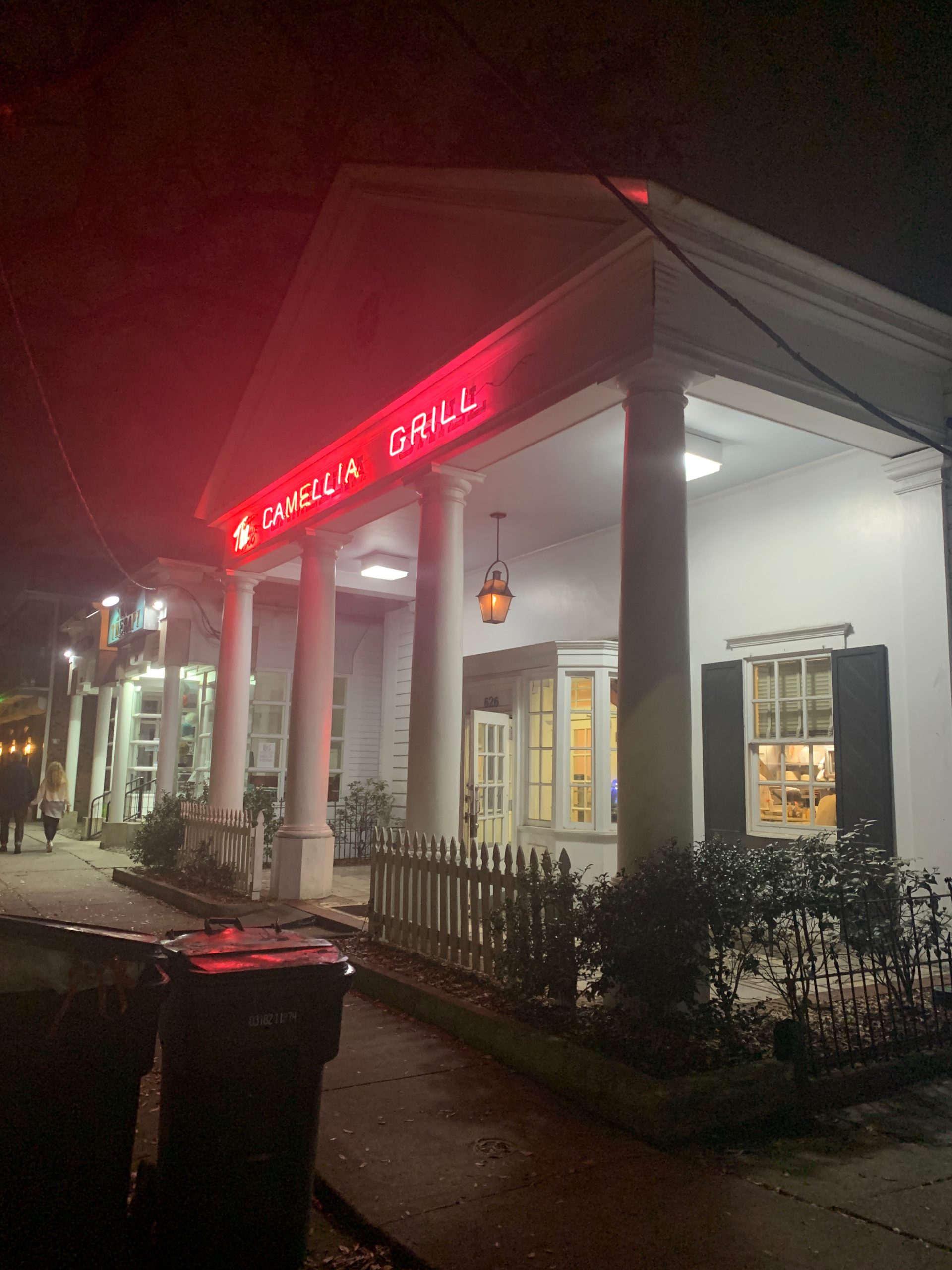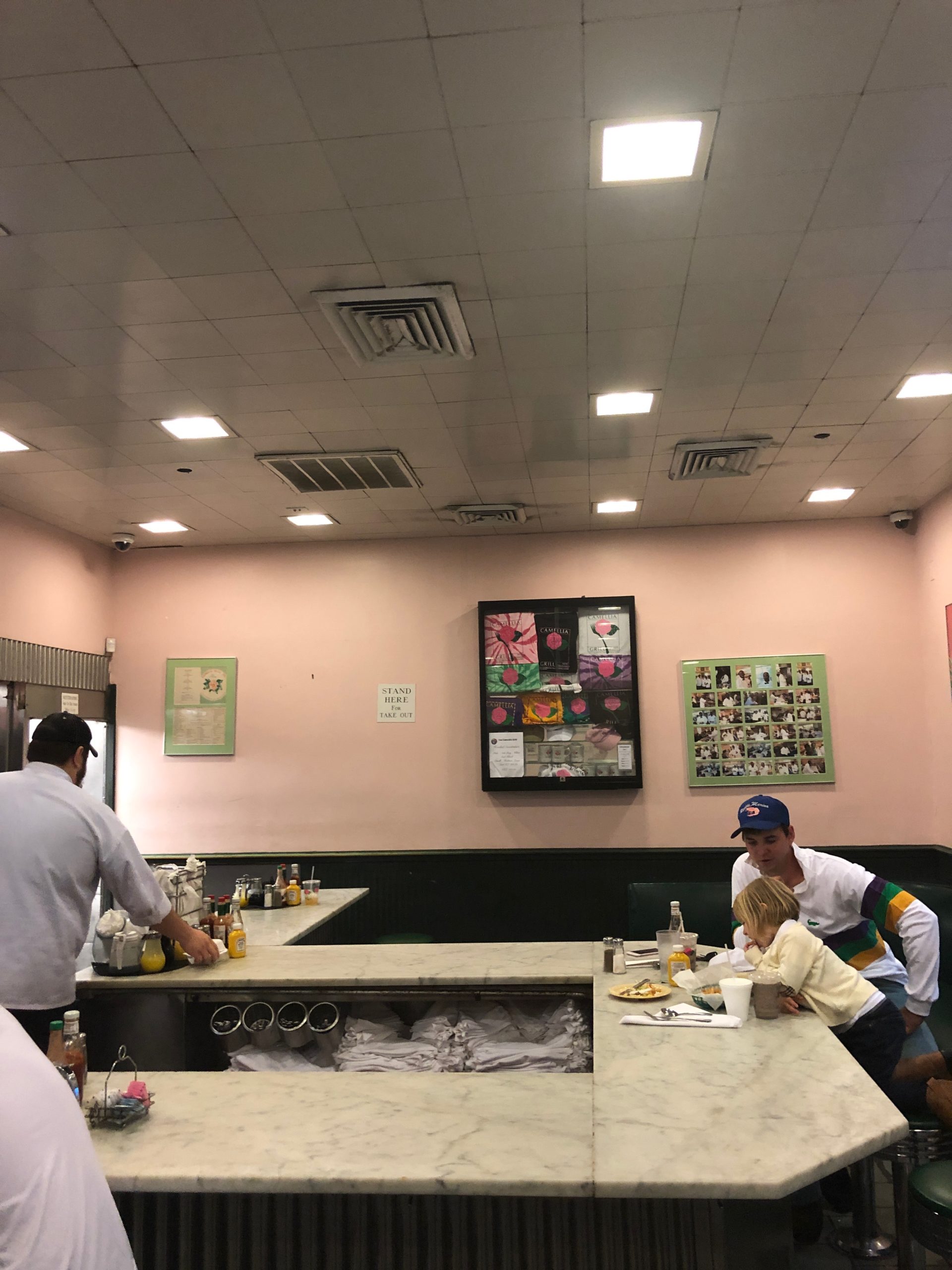
Outside of Camellia Grill.
(Photo by: Alex Chesen)
The man working the counter at Camellia Grill rattled off orders as the griddle sizzled in the background. The restaurant was all but empty, aside from my 3 friends and I, as well as a father with his young child. Despite the low number of occupants in the building, there was plenty to hear. Spatulas clanked against the oily, crackling grill, as the chef sliced up eggs and hot dogs. A recurring pattern that stood out to me during the 2 minutes of audio I recorded was the aforementioned employee making sure the few customers he was serving were taken care of. In the short time I spent at Camellia Grill that night, it became clear that one concern was deeply embedded into the history of this space: performing to optimize the customer experience. The audio I recorded demonstrates that Camellia Grill operates as a stage in order for its staff to accomplish the social functions associated with transactional dining.
At the beginning of my recording, the waiter called out our orders to the chef for the whole restaurant to hear: “Alright Ed… We gotta… Veggie Omelette with hash browns… 2 chili dogs with cheese… A breakfast po-boy, dressed… ”. Between each item announced, the waiter held a momentary pause. It’s possible this was to give his chef time to process the order he was given, but I would argue that this presentation of our orders was strategically done for the benefit of the customers. As you can hear on the recording, all talking in the restaurant stopped as the man read off our orders. Conversations did not resume until he was finished. There was a performative element in the way this moment transpired. For a 20 second span, it was as if the restaurant staff were putting on a display for us as an audience. The pauses in between orders served to let the customers silently take in every second of this theatrical act, and recognize Camellia Grill as an establishment committed to fitting a preconceived conception of a New Orleans restaurant, committed to caring for its customers.
According to The New Encyclopedia of Southern Culture: Volume 16: Sports and Recreation by Curtis Whittington, New Orleans was one of the earliest cities in the United States to adopt restaurants as a form of “commercial hospitality”(1). Whittington explains: “As the southerner traveled to cities such as… New Orleans, his chances of finding good food served well in commercial settings improved”(1). The aforementioned sound I recorded — the waiter reading out our orders for everyone to hear — reflects a current history being made where both high quality food and good service are audibly embedded and subsequently reinforced into the customer’s dining experience. Whittington notes that, “Great restaurants from the past continue to flourish in New Orleans- a city that remains unique throughout the region”(1). This quote reflects a shared history amongst New Orleans restaurants that Camellia Grill adheres to. This history, both past and present, manifests itself in an apparent preparedness to serve efficiently and conveniently for guests. The loud reading of our orders at the beginning of the recording is this employee’s way letting us know that, as paying customers, he fully intended to be there for us to make sure our experience would be the best that it could be. By doing so, this employee is actively partaking in Camellia’s adherence to this history associated with New Orleans restaurants.

Inside Camellia Grill (Photo by: Jake Rush)
In his book, Food in Time and Place: The American Historical Association Companion to Food History, Paul Freedman explains how the act of going to a specific restaurant represents the ultimate form of individuals creating the ideal dining experience for themselves. Freedman says: “Restaurants tend to be favored for what diners cannot easily cook at home by reason of either exotic ingredients or technology”(2). Indeed, the technology of Camellia’s literal grill, as well as its famous southern home food, such as the chili dogs and po-boys mentioned in the recording, serve as literal ingredients and technology that attract customers. However, the sounds of the orders being read aloud offer insights into a similar type of “exotic ingredient.” This idea refers to the feeling of being “at home” which Camellia’s employees clearly strive to give their customers. Throughout the meal, employees work hard to take care of complete strangers.
This metaphorical ingredient of commitment to service can be heard throughout the entire 2 minute recording. After the waiter had finished reading off our orders, my friends and I resumed conversation. 10 seconds later, he briefly interjected into our conversation to ask “You guys want anything besides water?” Our conversation again briefly stopped to accommodate this audible performance of service. 20 seconds later forks and knives could be heard being placed in front of us on the marble counter. Again, our conversation paused as a subtle acknowledgement to the display of aid being given to us as paying customers. When the waiter placed our forks and knives down on the counter, my friend, Andrew, paused his conversation with my other friend to say, “Thank you, sir,” before immediately resuming his thought. This break from our intimate, four-person dining experience allowed for a momentary appreciation of the employee. Hearing the phrase “Thank you, sir,” immediately after the audio of the utensils being placed on the counter represents Andrew’s acknowledgement that this server, as well as Camellia Grill as a whole, is achieving his goal to fulfill the history that Whittington discusses about New Orleans restaurants.
These pauses indicate an assumption by server and patron that both parties will participate in this social performance of transactional eating. The rules are implied from societal norms: customers interact with their own personal social sphere and the server will interrupt merely to serve his or her social function of making sure the customer is adequately taken care of, representing that metaphorical “ingredient” of quality service that Freedman argues make restaurants desirable. The pauses also reveal an underlying truth about the psychology of transactional eating: total strangers will conduct civil interactions between each other, so long as there is an exchange of currency to symbolize order. The server is obviously being paid to do this job. On page 254 of his book, Freedman explains the previously mentioned social sphere customers get in return: “The notion of choice is important: the customer fixes a time… decides what to order… and sits alone or with self-selected companions in a kind of privacy within the public space”(2).
What Freedman is getting at is that going to a restaurant to practice transactional eating is an attempt by the consumer to create the best possible meal and social setting they can. This means literally in terms of food, but also in terms of interpersonal experience. Fulfilling this process can be made easier in a restaurant like Camellia, committed to histories and narratives where aspects of the quintessential dining experience are already provided for them.
By working at Camellia Grill and providing audio heard in my recording, such as checking if water is an acceptable drink or putting our silverware on the counter, the server is holding up his end of an unspoken psychosocial agreement. By coming into this restaurant to be served, and providing audio such as “Thank You, sir” and silent pauses to let the server do his job, we have also accepted our implied role as patrons of this restaurant. The sounds of us engaging with each other — the reading of our orders, the waiter giving us our silverware, and us thanking him — function to show us both adhering to our roles as social actors in this setting. This relationship is symbiotic: we as patrons get our optimal dining experience, while the restaurant and its employees receive monetary profit in return.
Works Cited
 NOLAbeings
Multimedia artist Claire Bangser created NOLAbeings as a portrait-based story project that marries...
NOLAbeings
Multimedia artist Claire Bangser created NOLAbeings as a portrait-based story project that marries...
 Data corner: Adobe Suite (create a PDF, social media graphic, presentation, edit a photo and video
Data corner is where you go to work with analytics and top tech skills. It takes on everything from PERL and SQL to Canva and Sprout Social.
Data corner: Adobe Suite (create a PDF, social media graphic, presentation, edit a photo and video
Data corner is where you go to work with analytics and top tech skills. It takes on everything from PERL and SQL to Canva and Sprout Social.
